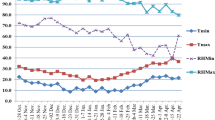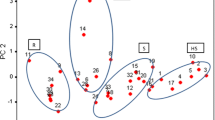Abstract
Nine spring lines of Polish wheat (Triticum polonicum) were compared with Kamut wheat and two common wheat cultivars. Plants were analyzed to determine morphometric parameters (plant height, spike length, spike density, grain weight per spike and single kernel weight) and some chemical properties of grain: content of protein, ash, fat, crude fiber, minerals and mycotoxins. The studied genotypes produced a relatively weak response to infection with Fusarium culmorum which was expressed by a decrease in grain weight per spike and single kernel weight by 13 % and over 6 %, respectively. The grain of T. polonicum was characterized by a significantly higher protein and ash content than the grain of common wheat (by 19.8 and 23.7 %, respectively) and considerably higher concentrations of fat and dietary fiber than Kamut wheat (by 30.2 and 17.4 %, respectively). In comparison with common wheat, the grain of the examined genotypes was significantly more abundant in sulfur, magnesium and potassium as well as zinc, iron, copper and molybdenum. It contained significantly less aluminum and strontium. The inoculation led to a significant increase in fusariotoxin levels in the grain of all studied genotypes, and the average concentrations of the above metabolites were lower in the grain of T. polonicum than in Triticum aestivum. Polish wheat may constitute valuable genetic material for breeding new wheat varieties characterized by a high nutritive value and satisfactory resistance to FHB.



Similar content being viewed by others
Abbreviations
- DON:
-
Deoxynivalenol
- D3G:
-
DON-3-Glucoside
- NIV:
-
Nivalenol
- ZEA:
-
Zearalenone
- AME:
-
Alternariol monomethyl ether
- α-ZOL:
-
Alpha-zearalenol
- β-ZOL:
-
Beta-zearalenol
- AOH:
-
Alternariol
- MON:
-
Moniliformin
- 15-MAS:
-
15-Monoacetoxyscirpenol
References
Acquaah G (ed) (2007). Breeding wheat. In: Principles of plant genetics and breeding. Blackwell Publishing, USA, pp 471–484
Angioloni A, Collar C (2011) Nutritional and functional added value of oat, Kamut®, spelt, rye and buckwheat versus common wheat in breadmaking. J Agric Food Chem 91:1283–1292
Benedetti S, Primiterra M, Tagliamonte MC, Carnevali A, Gianotti A, Bordoni A, Canestrari F (2012) Counteraction of oxidative damage in the rat liver by an ancient grain (Kamut brand khorasan wheat). Nutrition 28(4):436–441
Berthiller F, Dall’Asta C, Schumacher R, Lemmens M, Adam G, Krska R (2005) Masked mycotoxins: determination of a deoxynivalenol glucoside in artificially and naturally contaminated wheat by liquid chromatography–tandem mass spectrometry. J Agric Food Chem 53:3421–3425
Bottalico A (1998) Fusarium diseases of cereals: species complex and related mycotoxin profiles in Europe. J Plant Path 80(2):85–103
Caballero L, Martín LM, Alvarez JB (2008) Variation of high molecular weight glutenin subunits in two neglected tetraploid wheat subspecies. Czech J Genet Plant Breed 44(4):140–146
Cakmak I (2010) Biofortification of cereals with zinc and iron through fertilization strategy. In: 19th world congress of soil science, soil solutions for a changing world, Brisbane, 1–6 August 2010, pp 4–6
Colomba MS, Gregorini A (2012) Are ancient durum wheats less toxic to celiac patients? A study of α-Gliadin from Graziella Ra and Kamut. Sci World J 2012(837416). doi:10.1100/2012/837416
Dorofeev VF (1987) Pšenica polonicum (T. polonicum L.). In: Dorofeev VF (ed) Pšenicy mira: Vidovoj sostav, dostiženiâ selekcii, sovremennye problemy i ishodnyj material, 2nd edn. Leningrad, Kolos, pp 48–50
Eticha F, Belay G, Bekele E (2006) Species diversity in wheat landrace populations from two regions of Ethiopia. Genet Resour Crop Evol 53:387–393
Fan MS, Zhao FJ, Fairweather-Tait SJ, Poulton PR, Dunham SJ, McGrath SP (2008) Evidence of decreasing mineral density in wheat grain over the last 160 years. J Trace Elem Med Bio 22(4):315–324
Hammer K, Filatenko AA, Pistrick K (2011) Taxonomic remarks on Triticum L. and × Triticosecale Wittm. Genet Resour Crop Evol 58:3–10
Holden C (1998) Wonder wheat. Science 280(5363):527
Hoseney RC (1994) Principles of cereal science and technology. American Association of Cereal Chemists (ed) Inc., St Paul, MN, pp 65–79, 87–93
Jackowiak H, Packa D, Wiwart M, Perkowski J (2005) Scanning electron microscopy of Fusarium damaged kernels of spring wheat. Int J Food Microbiol 98(2):113–123
Kang H-Y, Lin L-J, Song Z-J, Yuan J-Y, Zhong M-Y, Zhang H-Q, Fan X, Sha L-N, Wang Y, Xu L–L, Zeng J, Zhou Y-H (2012) Identification, fine mapping and characterization of Rht-dp, a recessive wheat dwarfing (reduced height) gene derived from Triticum polonicum. Genes Genom. doi:10.1007/s13258-012-0022-z
Kang H-Y, Wang Y, Yuan H-J, Jiang J, Zhou Y-H (2008) A new synthetized 6x-wheats, derived from dwarfing Polish wheat (Triticum polonicum L.) and Aegilops tauschii Cosson. Int J Agr Res 3(4):252–260
Khlestkina EK, Röder MS, Grausgruber H, Börner A (2006) A DNA fingerprinting-based taxonomic allocation of Kamut wheat. Plant Genet Res Characterization Util 4(3):172–180
Kokkonen M, Ojala L, Parikka P, Jestoi M (2010) Mycotoxin production of selected Fusarium species at different culture conditions. Int J Food Microbiol 143:17–25
Lemmens M, Scholz U, Berthiller F, Dall’Asta C, Koutnik A, Schuhmacher R, Adam G, Buerstmayr H, Mesterházy Á, Krska R, Ruckenbauer P (2005) The ability to detoxify the mycotoxins deoxynivalenol colocalizes with a major quantitative trait locus for Fusarium head blight resistance in wheat. Mol Plant Microbe Interact 18:1318–1324
Linnaeus C (1797) Species plantarum: exhibentes plantas rite cognitas, ad genera relatas, cum differentiis specificis, nominibus trivialibus, synonymis selectis, locis natalibus, secundum systema sexuale digestas. Impensis G. C. Nauk, Berolini, p 478
List of Agriculture Cultivars (2008) Research center for cultivar testing. Słupia Wielka, Poland
Marotti I, Bregola V, Aloisio I, Di Gioia D, Bosi S, Di Silvestro R, Quinn R, Dinelli G (2011) Prebiotic effect of soluble fibres from modern and old durum-type wheat varieties on Lactobacillus and Bifidobacterium strains. J Sci Food Agric 92:2133–2140
Matthäus K, Dänicke S, Vahjen W, Simon O, Wang J, Valenta H, Meyer K, Strumpf A, Ziesenib H, Flachowsky G (2004) Progression of mycotoxin and nutrient concentrations in wheat after inoculation with Fusarium culmorum. Arch Anim Nutr 58(1):19–35
Mizuno N, Hosogi N, Park P, Takumi S (2010) Hypersensitive response-like reaction is associated with hybrid necrosis in interspecific crosses between tetraploid wheat and Aegilops tauschii Coss. PLoS ONE 5(6):e11326
Nevo E (2011) Triticum. In: Kole C (ed) Wild crop relatives: genomic and breeding resources. Cereals. Springer, Heidelberg, pp 407–456
Oliver RE, Cai X, Friesen TL, Halley S, Stack RW, Xu SS (2008) Evaluation of Fusarium head blight resistance in tetraploid wheat (Triticum turgidum L.). Crop Sci 48:213–222
Pan D, Hong L, Wei L, Peng-Fei Q, Yu-Ming W, Zheng YL (2007) Genetic diversity of storage protein in Triticum polonicum L. J Plant Sci 2(4):416–424
Piergiovanni AR, Simeone R, Pasqualone A (2009) Composition of whole and refined meals of Kamut under southern Italian conditions. Chem Eng Trans 17:891–896
Piergiovanni AR, Rizzi R, Pannacciulli E, Della Gatta C (1997) Mineral composition in hulled wheat grains: a comparison between emmer (Triticum dicoccon Schrank) and spelt (T. spelta L.) accessions. Int J Food Sci Nutr 4(6):381–386
Piironen V, Lampi A, Ekholm P, Salmenkallio-Marttila M, Liukkonen K (2009) Micronutrients and phytochemcials in wheat grain. In: Khan PK, Shewry P (eds) Wheat: chemistry and technology, 4th edn. AACC International, St Paul, pp 179–222
Quinn RM (1999) Kamut®: ancient grain, new cereal. In: Janick J (ed) Perspectives on new crops and new uses. ASHS Press, Alexandria, pp 182–183
Rajaram S, Dubin HJ (1999) Can yield potential of wheat be increased? In: CIMMYT. 1999. The tenth regional wheat workshop for Eastern, Central and Southern Africa. Addis Ababa, CIMMYT, pp 1–7
Richard JL (2007) Some major mycotoxins and their mycotoxicoses: an overview. Int J Food Microbiol 119:3–10
Rodríguez-Quijano M, Lucas R, Carrillo JM (2003) Waxy proteins and amylose content in tetraploid wheats Triticum dicoccum Schübl., Triticum durum L. and Triticum polonicum L. Euphytica 134:97–101
Rogers MAM, Simon DG (1999) Aluminium intake and risk of Alzheimer’s disease. Age Ageing 28(2):205–209
Ruel MT, Buis HE (1998) Plant breeding: a long-term strategy for the control of zinc deficiency in vulnerable populations. Am J Clin Nutr 68(suppl):488–494
Simonato B, Pasini G, Giannattasio M, Curioni A (2002) Allergenic potential of Kamut® wheat. Allergy 57:653–654
Sissons MJ, Batey IL (2003) Protein and starch properties of some tetraploid wheats. Cereal Chem 80(4):468–475
Siuda R, Grabowski A, Lenc L, Ralcewicz M, Spychaj-Fabisiak E (2010) Influence of the degree of fusariosis on technological traits of wheat grain. Int J Food Sci Technol 45(2):2596–2604
Spanic V, Drezner G, Horvat D (2012) Changes of agronomic and quality traits in Fusarium-inoculated wheat genotypes. Croat J Food Technol Biotechnol Nutr 7(1–2):85–89
Stack RW, Elias EM, Mitchell Fetch J, Miller JD, Joppa LR (2002) Fusarium head blight reaction of Langdon durum-Triticum dicoccoides chromosome substitution lines. Crop Sci 42:637–642
Stallknecht GF, Gilbertson KM, Ranney JE (1996) Alternative wheat cereals as food grains: Einkorn, emmer, spelt, kamut, and triticale. In: Janick J (ed) Progress in new crops. ASHS Press, Alexandria, pp 156–170
Steiner B, Lemmens M, Griesser M, Scholz U, Schondelmaier J, Buerstmayr H (2004) Molecular mapping of resistance to Fusarium head blight in the spring wheat cultivar Frontana. Theor Appl Genet 109(1):215–224
Suchowilska E, Wiwart M, Kandler W, Krska R (2012) A comparison of macro- and microelement concentrations in the whole grain of four Triticum species. Plant Soil Env 58(3):141–147
Suchowilska E, Kandler W, Sulyok M, Wiwart M, Krska R (2010) Mycotoxin profiles in the grain of Triticum monococcum, Triticum dicoccum and Triticum spelta after head infection with Fusarium culmorum. J Sci Food Agric 90:556–565
Wagacha JM, Muthomi JW (2005) Fusarium culmorum: infection process, mechanisms of mycotoxin production and their role in pathogenesis in wheat. Crop Prot 26(7):877–885
Wang H-J, Huang X-Q, Röder MS, Börner A (2002) Genetic mapping of loci determining long glumes in the genus Triticum. Euphytica 123:287–293
Watanabe N (2004) Triticum polonicum IC12196: a possible alternative source of GA3-insensitive semi-dwarfism. Cereal Res Commun 32:429–434
Wijaya GY, Maresa DJ (2012) Apigenin di-C-glycosides (ACG) content and composition in grains of bread wheat (Triticum aestivum) and related species. J Cereal Sci. doi:10.1016/j.jcs.2012.06.007
Witzenberger A, van den Hack H, Boom T (1989) Erläuterungen zum BBCH-Dezimal-code für die Entwicklungsstadien des Getreides—mit Abbildungen. Ges Pfl 41:384–388
Wiwart M, Perkowski J, Budzyński W, Suchowilska E, Buśko M, Matysiak A (2011) Concentrations of Ergosterol and Trichothecenes in the Grains of Three Triticum species. Czech J Food Sci 29(4):430–440
Zou CQ, Zhang YQ, Rashid A, Ram H, Savasli E, Arisoy RZ, Ortiz-Monasterio I, Simunji S, Wang ZH, Sohu V, Hassan M, Kaya Y, Onder O, Lungu O, Yaqub Mujahid M, Joshi AK, Zelenskiy Y, Zhang FS, Cakmak I (2012) Biofortification of wheat with zinc through zinc fertilization in seven countries. Plant Soil. doi:10.1007/s11104-012-1369-2
Web sites
http://www.kamut.com. Accessed 24 Oct 2012.
http://www.pureplanet.com/productpage.aspx?itemid=623. Accessed 24 Oct 2012.
http://www.ars-grin.gov/cgi-bin/npgs/html/taxon.pl?406898. Accessed 24 Oct 2012.
Acknowledgments
This work was supported by the Polish Ministry of Science and Higher Education, Project No. 0882/B/P01/2009/37.
Author information
Authors and Affiliations
Corresponding author
Rights and permissions
About this article
Cite this article
Wiwart, M., Suchowilska, E., Kandler, W. et al. Can Polish wheat (Triticum polonicum L.) be an interesting gene source for breeding wheat cultivars with increased resistance to Fusarium head blight?. Genet Resour Crop Evol 60, 2359–2373 (2013). https://doi.org/10.1007/s10722-013-0004-2
Received:
Accepted:
Published:
Issue Date:
DOI: https://doi.org/10.1007/s10722-013-0004-2




